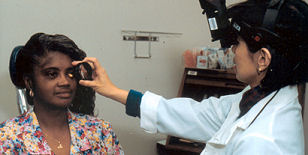How Do Eye Doctors Check for Glaucoma?
There are three major signs that a person may have glaucoma:
- Optic nerve damage
- Vision loss (visual field loss)
- Increased eye pressure (elevated intraocular pressure).
Your eye doctor will check your eyes using some of these tests:
Ophthalmoscopy The doctor will place a few drops in your eye to open or dilate the pupil. This allows the doctor a clearer view to inspect the optic nerve at the back of the eye.
Dilated Eye Exam

Credit: National Eye Institute, National Institutes of Health
Photography or laser scanning may be used to show the appearance of the optic nerve inside your eye. This will also involve dilating your eye.
Tonometry measures pressure in the eye. Medicine drops are used to numb the eye. An instrument gently presses on the outside of your eye. Pressure is shown as a number followed by the abbreviation "mm Hg." This stands for "millimeters of mercury," a standard measure for pressure. An average pressure is about 16 mm Hg. Still, a higher than average number doesn't always mean you have glaucoma. Since the thickness of the cornea (the front window of the eye) may affect the pressure reading and the risk of glaucoma progression, your doctor may measure this as well.
Perimetry evaluates your visual field. This tests your vision all around your field of view to see if any areas
are missing. It usually involves staring straight ahead at
a light and trying to see lights that appear around the sides of your view. This is generally done with a computerized system.
Gonioscopy After numbing the eye, the doctor gently places a special lens on the surface to examine the area in the front of the eye that drains fluid. Gonioscopy allows a more accurate diagnosis of the type of glaucoma.






